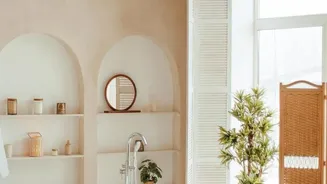Discover the secrets of creating your serene meditation spaces at home. Dive into tips to design your oasis
In today's fast-paced world, finding a moment of peace can feel like a distant dream. Juggling
work deadlines, family responsibilities, and the constant hum of digital distractions, it's easy to feel overwhelmed and stressed.

But what if I told you that inner peace could be just a few steps away, right within the walls of your own home? Creating a dedicated meditation space is like carving out a sanctuary, a haven where you can disconnect from the chaos and reconnect with your inner self.
You don't need a sprawling mansion or a hefty budget to achieve this. With a little creativity and intention, you can transform any corner of your home into a tranquil oasis where you can practice the art of serenity.
This article offers practical tips and inspiring ideas to help you design your personal meditation space. Whether you reside in a bustling Mumbai apartment or a serene Kerala bungalow, these suggestions can be adapted to suit your unique needs and style.
We'll explore how to utilise colour, light, sound, and even scents to create an atmosphere that promotes relaxation and mindfulness. From minimalist zen gardens to cosy reading nooks, we'll uncover seven distinct meditation space themes you can easily create at home.
Get ready to embark on a journey of self-discovery and craft a dedicated space for your well-being. Are you ready to unlock the power of mindful meditation and experience the tranquility you deserve? Let's find out how to create the perfect meditation space for you, right in your very own home.
The Minimalist Zen Garden
Embrace simplicity here. Channel the essence of Japanese Zen gardens with clean lines and natural elements. Start with a small, uncluttered area, like a corner of your bedroom or balcony. The goal is to minimise visual distractions.
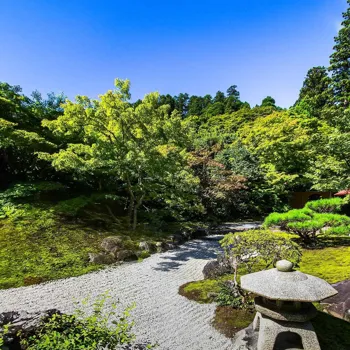
Opt for a calming colour palette of whites, creams, and natural greens. Introduce a few carefully chosen elements, like a small bonsai tree, a smooth river stone, or a miniature sand garden. These items promote mindfulness and connect you to nature, even indoors.
Consider investing in a comfortable meditation cushion or a simple, low bench. Good posture is important for maintaining focus during meditation. Remember, less is more! Keep the space free of clutter and any objects that might distract your mind.
Light is key in a Zen garden.
Natural light is ideal, so try to position your space near a window. If natural light is limited, use soft, diffused artificial light. Avoid harsh overhead lighting, which can be jarring and interfere with relaxation.
As for the sounds, calming instrumental music can enhance the tranquil atmosphere. Opt for gentle melodies or nature sounds like flowing water or birdsong. If you prefer silence, consider using noise-cancelling headphones to block out unwanted distractions.
You can also look at using essential oils like lavender or sandalwood. Their calming aromas help promote relaxation and enhance your meditation practice. The minimalist zen garden is a sanctuary for cultivating inner peace.
The Cosy Reading Nook Sanctuary
Transform a corner of your living room or bedroom into a warm and inviting reading nook. Choose a comfortable armchair or a plush floor cushion as your anchor. Surround yourself with your favourite books and create a personal library that evokes feelings of comfort and joy. Soft lighting is a must.
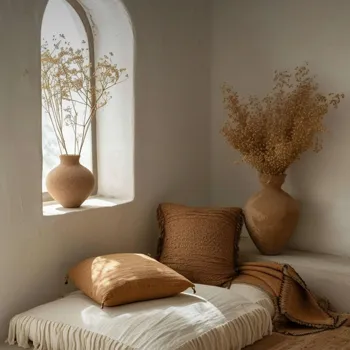
String fairy lights, place a reading lamp with a warm-toned bulb, or use candles to cast a gentle glow. Layering textures can also create a sense of cosiness. Drape a soft throw blanket over your chair, add a few decorative pillows, and place a plush rug underfoot.
Plants are a fantastic way to bring life and vibrancy into your reading nook. Choose low-maintenance varieties that thrive in low light conditions, such as snake plants or ferns.
Personalise this and decorate with items that bring you joy.
Add photos of loved ones, souvenirs from travels, or handmade crafts. The goal is to create a space that resonates with your personality and makes you feel at ease. When it comes to sound, complete silence is not required here. The gentle rustle of pages from your book can be quite soothing.
However, be sure to minimise external distractions. Close the door, turn off your phone, and let others know that you need some quiet time. While reading, the nook becomes a portal to different worlds and experiences. Use the quiet time to meditate.
Focus on your breath and allow thoughts to flow through your mind like clouds in the sky.
The Nature-Inspired Oasis
Bring the outdoors in by creating a nature-inspired meditation space. Choose a room with ample natural light and plenty of space for plants. Fill the room with a variety of greenery, from potted plants to hanging baskets. Choose plants with different textures and shapes to create visual interest.
Consider adding elements like a small water fountain or a collection of seashells to enhance the connection to nature. The sound of trickling water can be incredibly soothing and promote relaxation. Use natural materials wherever possible. Opt for furniture made from wood, bamboo, or rattan.
Choose fabrics made from natural fibres like cotton, linen, or jute. These materials are breathable, comfortable, and environmentally friendly.
Visuals are important, so use natural colours. Choose a calming colour palette of greens, browns, blues, and earthy tones.
These colours evoke feelings of peace and harmony. You might want to consider painting a mural of a forest scene or a seascape on one of the walls. The scent of nature will keep you grounded and at peace. Use essential oils like cedarwood, pine, or eucalyptus to create a woodland aroma.
Fresh flowers can also add a touch of natural fragrance to your space. Let your oasis become your sanctuary. Close your eyes, listen to the sounds of nature, and allow yourself to be transported to a peaceful natural environment.
The nature-inspired oasis is a refuge from the stresses of urban life, a place to reconnect with the earth.
The Colour Therapy Corner
Harness the power of colour to create a meditation space that promotes well-being. Different colours have different effects on our mood and emotions. Research the psychology of colour and choose a palette that resonates with you. Blue is known for its calming and soothing properties.

It can help to reduce stress and anxiety. Green is associated with nature, growth, and harmony. It can help to promote feelings of balance and well-being. Yellow is associated with happiness, optimism, and creativity. It can help boost your mood and stimulate your mind.
Incorporate your chosen colours into the space through paint, furniture, accessories, and lighting.
If you choose blue, you could paint the walls a soft shade of blue and add blue cushions, throws, and artwork. With the same colour, use blue-tinted lighting to enhance the calming effect.
If you prefer green, fill the space with plants and use green fabrics and accessories. Consider using green-coloured lighting to create a calming and verdant atmosphere. A yellow room would enhance an energising mood.
Paint the walls a cheerful shade of yellow and add yellow accents throughout the space. The lighting can be bright and sunny to boost your mood and promote productivity. Be careful about an overload of any colour. Experiment with different colour combinations to find the perfect balance.
Consider using colour blocking or ombre effects to create visual interest.
The Sound Healing Sanctuary
Immerse yourself in the healing power of sound by creating a sanctuary dedicated to sound therapy. Invest in a high-quality sound system and a collection of sound healing instruments. You could use singing bowls, tuning forks, gongs, and ocean drums.
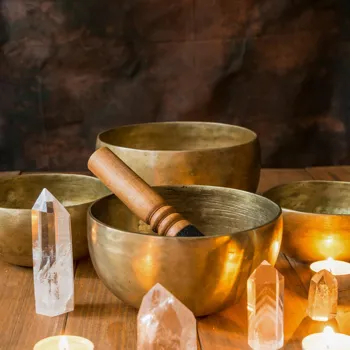
These instruments produce vibrations that can help to promote relaxation, reduce stress, and balance your energy. Create a playlist of your favourite sound healing tracks. Choose music that resonates with you and helps you to enter a meditative state.
Consider attending sound healing sessions to learn how to use the instruments effectively.
Use acoustic panels or thick curtains to create a soundproof environment. This will help to block out external noises and create a more immersive sound experience.
You can adjust the frequency to the best experience for your body. Pay attention to how different sounds affect you and choose instruments and music that promote feelings of peace and well-being. Use calming scents by adding essential oils to your diffuser. Let the soothing smells envelop the room.
The Sacred Space Altar
Designate a small area of your home as a sacred space where you can connect with your spirituality. This could be a corner of your bedroom, a shelf in your living room, or even a small table. Place objects that are meaningful to you on the altar.
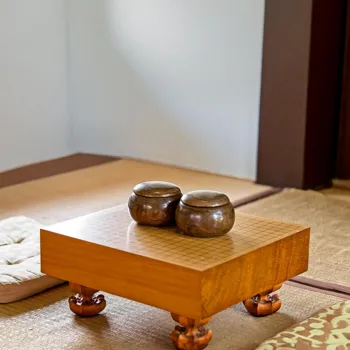
This could include religious icons, crystals, candles, essential oils, or personal mementos. The altar should be a reflection of your personal beliefs and values. Decorate the space mindfully with items that inspire you.
Use a beautiful cloth to cover the altar, adding flowers or plants, and arrange the items in a way that is pleasing to the eye.
Regularly cleanse and purify the space with sage or incense. This will help to remove any negative energy and create a more sacred atmosphere.
Spend time each day in your sacred space, praying, meditating, or simply reflecting on your gratitude. Journaling for reflection helps to calm the mind and focus. Set your intentions for the day and visualise your desired future. Let the ambience bring inner peace and well-being.
It's a space for quiet contemplation, spiritual connection, and personal growth.
The Creative Expression Studio
Unleash your creativity and nurture your inner artist by creating a dedicated space for artistic expression. In it, create an inspirational mood board with images and quotes that spark your imagination. Gather your art supplies and arrange them in an organised and visually appealing way.
This will encourage you to engage in creative activities. Allow plenty of space for your artwork. Hang your paintings on the walls, display your sculptures on shelves, or lay out your drawings on a table. Keep the space clean but don't be afraid to make a mess.
Play upbeat music that inspires and motivates you. Dance or move your body to get your creative juices flowing. Write, read poetry, visualise, or paint to open your mind. Use essential oils like lemon or peppermint to promote energy and focus.
Light candles or incense to create a calming and inspiring atmosphere. Embrace imperfection and allow yourself to experiment and explore without judgement. Remember, the goal is not to create a masterpiece, but to express yourself authentically and have fun. Allow yourself to play and explore.
This is a sanctuary for creative exploration.
AI Generated Content. Glance/InMobi shall have no liability for the content
